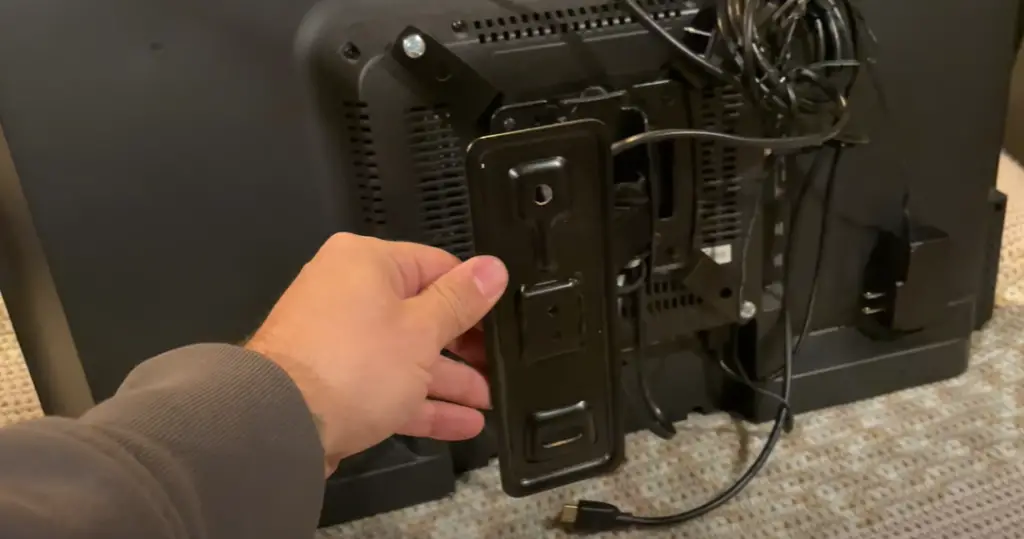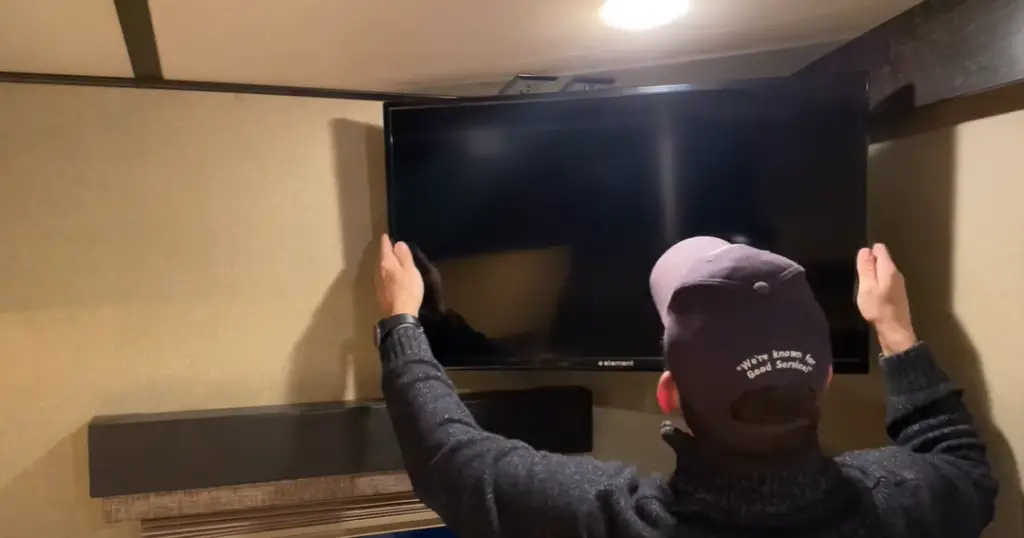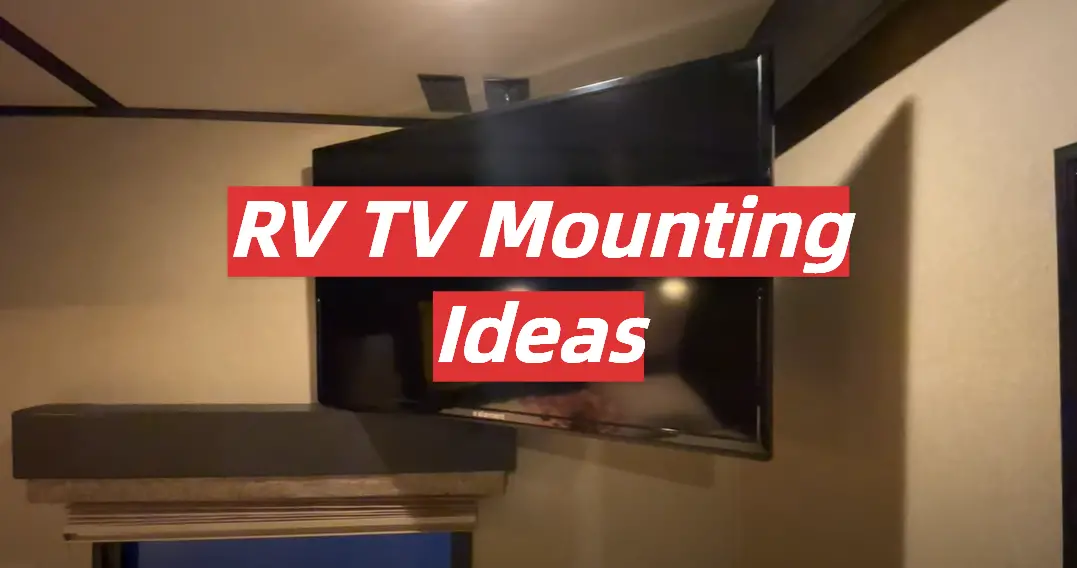With more and more people spending time in RVs, an important factor for comfort and enjoyment is finding creative yet practical ways to mount your TV. Whether it’s a small screen or a larger display, there are several choices to consider when maximizing your RV viewing pleasure. By exploring the different options available today, you can make sure that your TV is securely mounted for safe and enjoyable use on the road.
Table of Contents
Why do you need a TV in your RV?
Having a TV in your RV provides the perfect way to stay entertained while on the road. Whether you’re staying put at a campsite or heading out for an adventure, having access to movies, shows, and games can make your travels more enjoyable. With a dedicated TV, you won’t have to strain your eyes watching content off of small laptop screens or tablets. It also adds some familiarity and coziness to your home away from home. Additionally, if you’re traveling with children, television can be a great source of entertainment for them when they need a break from outdoor activities.
When shopping around for a television for your RV, several features should be taken into consideration such as size (smaller is usually better), resolution (HD or 4K for sharper images), and wattage (important for battery conservation). You’ll also want to think about whether you need an antenna, satellite dish, or streaming services like Netflix. With the right setup, a TV in your RV can be an invaluable addition to your home on wheels. So make sure to think about the benefits before you hit the road without one.

Things To Consider Before Buying a TV For Your RV
Physical Size of The TV
When choosing a TV for your RV, size is an important factor to consider. You don’t want something so big that it takes up most of the available space in your living area. But at the same time, you don’t want something too small that makes watching shows and movies difficult. It’s best to measure the available area where you will be placing the TV first before deciding on size.
Resolution and Refresh Rate
The resolution and refresh rate of a TV determines how sharp and realistic images look on screen. When shopping around for a new TV, look for models with at least 1080p resolution or higher (4K is ideal). Also, make sure to check out the refresh rate; this determines how fast images can be updated on the screen. Higher refresh rates are better for gaming and fast-paced action movies.
Connectivity Options
Depending on where you’ll be staying, having access to a TV signal might not always be available. That’s why it’s important to check out the connectivity options of your new TV before making a purchase. Make sure that it has an antenna port, HDMI ports, and other inputs so that you can easily hook up devices like laptops, game consoles, streaming boxes, and more. Additionally, some newer TVs come with built-in Wi-Fi capabilities which make accessing content from the internet easy.
Power Requirements
Consider how much power your new TV will require while in use. This is especially important for those using their RV’s batteries for power. Look for models that are Energy Star certified to ensure they use less energy and won’t drain your battery quickly. Also, you can invest in a surge protector or an inverter to help reduce the load on your power supply when running multiple devices at once.
Weight of The TV
Weight is an important factor to consider when looking for a TV for your RV. If you’re looking at larger models, make sure that the weight won’t be too much of a burden on your vehicle. You don’t want to damage your RV by carrying too much weight around. Additionally, lighter TVs are easier to mount and carry around if need be. On average, a decent-sized flat-screen TV can weigh anywhere between 15 to 30 pounds.

Available Mounting Options
You’ll need to decide how you want to mount your TV for it to fit properly into your RV. Wall-mounted TVs are the most popular option as they keep the screen out of reach and allow for more living space. However, there are other mounting options available such as ceiling mounts or stands if wall mounting isn’t an option. Make sure to measure the area where you plan on installing the TV beforehand so that you can find a compatible mounting solution.
The Flexibility of The Mount
Make sure to consider how flexible the mount needs to be. If you plan on driving with your TV mounted, then you’ll want a mount that can swivel and tilt so that it won’t move around too much while in transit. Alternatively, if you’re planning on staying in one place for a while, then a fixed mount might be more suitable [1].
Price
Last but not least, price should always be taken into consideration when shopping around for electronics. When it comes to TVs, there is a wide range of prices so it’s best to do some research before making a purchase. Consider what features you need and explore different options within your budget range to get the most out of your money. The average price for a decent-sized HDTV is anywhere from $200 – $400.
Best RV TV Mount Ideas
Mounting the TV Outside
Outdoor TV mounting for your RV can be a great way to enjoy the outdoors while still having access to all of your favorite shows. There are several different options available, ranging from permanent installations to portable mounts that you can take with you on your travels. The type of mount you choose should depend on the size and weight of your television, as well as its intended use. If you plan to watch movies or other long-form content outside, a heavier-duty mount may be necessary.
Mounting Underneath an Awning
If you have an existing awning on your RV, mounting the TV underneath it can provide a convenient solution for watching in both sunny and rainy conditions. This type of installation usually requires some specialized hardware to ensure that the TV is securely attached, and may need to be periodically adjusted for optimal viewing angles.
Mounting on the Wall or Ceiling
Another popular option for RV TVs is a wall or ceiling mount. These mounts are usually quite easy to install and provide an unobtrusive way to watch your favorite shows while taking up minimal space. Depending on the type of mount used, you may even be able to adjust the angle and distance from the television for optimal viewing pleasure.

Mounting with a Standalone Bracket
For those who want a more permanent solution, installing a standalone bracket can be an ideal choice. This type of bracket typically has adjustable arms designed specifically for mounting televisions in RVs, allowing you to easily adjust the orientation of the TV without having to purchase additional hardware. Additionally, these brackets are usually designed with a sturdy base that is capable of supporting larger televisions for extended periods.
Mounting the TV Under a Cabinet
For an easy and discrete solution, consider mounting your TV underneath one of the cabinets in your RV. This will not only save space but also provide you with a convenient way to watch without having to adjust the orientation or position of the television. Additionally, if you want to hide the TV when it is not in use, this option may be perfect for you.
Mounting on an Arm Bracket
Arm brackets are a great option for those who need maximum flexibility when it comes to positioning their TV. These mounts typically feature adjustable arms that can be extended outward from the wall or ceiling, allowing you to easily rotate and tilt the TV as needed for optimal viewing angles. Additionally, arm brackets are usually designed with a sturdy base that can support heavier TV models.
Mounting the TV Inside a Cabinet
If you’re looking for an even more discreet solution, consider mounting your TV inside one of the cabinets in your RV. This can be a great way to hide the TV when it is not in use, as well as provide easy access when you want to watch. Depending on the size of your cabinet and the weight of the television, you may need specialized hardware or a wall mount to ensure that it is securely attached.
RV TV Mount with Full Motion Support
For those who want ultimate flexibility, a full-motion RV TV mount might be the perfect solution. These mounts feature adjustable arms that can be extended outward from the wall or ceiling, allowing you to easily adjust the orientation of the television for optimal viewing angles. Additionally, most full-motion mounts are designed with an extra-sturdy base that can support heavier TVs for more extended periods.
Fixed RV TV Wall Mount
For those who are looking for a more permanent solution, fixed RV TV wall mounts may be the ideal choice. These mounts usually require some specialized hardware or tools to install, but once in place, they can provide secure and reliable support for your television. Additionally, most of these mounts feature adjustable arms that allow you to easily rotate and tilt the TV as needed for optimal viewing angles.
Mounting with a Motorized Lift
For those who want the ultimate in convenience and flexibility, a motorized lift may be the perfect solution. This type of mount features an adjustable arm that can be extended outward from the wall or ceiling.
Tilted RV TV Mount
Tilted RV TV mounts can be a great option for those who want to enjoy their favorite shows without having to worry about adjustments. Additionally, most tilted mounts are designed with an extra-sturdy base capable of supporting heavier televisions for extended periods.

Overhead RV TV Mount
For those who want to mount their television in an overhead location, an overhead RV TV mount is a great option. Additionally, most of these mounts are designed with extra-sturdy bases capable of supporting heavier TVs for more extended periods [2].
What to Look for When Purchasing The best tv mount for RVs
Weight Limits
When choosing a tv mount for your RV, always check the manufacturer’s weight limit. You want to be sure your TV won’t weigh more than the mount can safely support. If you have an older model without given weight limits, it is best to err on the side of caution and buy one that has higher capacity than necessary.
Vibration Resistance
The bumps and jolts associated with RV travel can cause some serious movement in the TV mounted inside. To prevent this, look for a tv mount that has vibration resistance features. Some of these may include rubber grommets or dampeners near mounting points to reduce shock and rattle during transport.
Mounting Options
Different types of tv mounts will offer different mounting options. Most televisions can be mounted either on the wall or on the ceiling, but there are other more complex mounting systems available as well. Make sure to check out all available mounting styles before committing to a particular type of mount for your RV.
Dimensions
Double-check the overall dimensions of your tv mount. Make sure it fits within your RV’s interior and take into account any obstacles such as cabinets or furniture that may interfere with the TV’s viewable area. With these factors in mind, you can be sure to find a tv mount that meets your needs and keeps your television secure while on the road.
Installation
The installation process of a tv mount can vary depending on the type you choose. If you don’t feel confident in your ability to install it correctly, it may be best to seek professional help or purchase a pre-assembled model. This will ensure that the tv mount is properly and safely installed for optimal use and enjoyment during your travels.
Price
Finally, consider the cost of the tv mount when making a purchase. While quality should always be your primary focus, there are many budget-friendly options available as well so shop around to find the right one for you. With these considerations in mind, you can be sure to find the best tv mount for RVs that fits both your budget and RV adventure needs! The average price of such a mounting construction can range from $50 to about $150 depending on the features and design [3].

FAQ
Do RVs need special TV mounts?
Yes, RVs often require special TV mounts that are specifically designed to work in the limited space of an RV. These mounts can usually be found at RV supply stores or online. When purchasing a mount, make sure that it is rated for your particular size and weight of television, as well as the type of mounting surface you have in your RV (wall, ceiling, etc.). Additionally, some mounts may require additional brackets or accessories to properly fit into the unique shape of an RV. Be sure to read all product descriptions carefully before purchasing to ensure you get the right mount for your needs.
What kind of seating is available for RVs?
There are many types of seating options available for RVs, depending on the size and layout of your vehicle. Common seating options include sofas, recliners, captain chairs, theater seating, and bench seats. Additionally, many RV manufacturers offer custom furniture packages that can be installed in the interior of an RV to provide more comfortable seating arrangements. The best way to find the right seating for your RV is to first measure the available space and then look at various models online or in stores to find something that will fit perfectly within your vehicle’s design.
What type of mattress is best for an RV?
When shopping for a mattress for an RV bed, it’s important to consider factors such as size and material construction. Many RVs come with beds that are not standard sizes, so it can be helpful to measure your bed’s dimensions and then look for a mattress that matches. Additionally, many mattresses designed specifically for RVs come with special features such as cooling technology or support layers to provide a more comfortable sleeping experience. When selecting an RV mattress, make sure to consider the size of the bed, material construction, thickness, and any additional features that may be desired.
Do RVs have air conditioning?
Many modern RVs are equipped with air conditioners as standard equipment but it is important to check the specifications of your particular model before making any assumptions. Some smaller models may only offer ventilation fans or roof vents instead of full-fledged air conditioners. Additionally, some RV owners choose to install portable air conditioners in their vehicles, allowing them to stay cool even when out on the road.

What kind of TV mount do I need for an RV?
When shopping for a TV mount for an RV, you will need to consider several factors such as the size and weight of your television, the type of mounting surface in your vehicle (wall, ceiling, etc.), and any additional brackets or accessories that may be required. When choosing a mount, it is also important to make sure that it is rated specifically for use in RVs. Many RV supply stores or online retailers offer mounts designed specifically for this purpose. Be sure to read all product descriptions carefully before purchasing to ensure you get the right mount for your needs.
Do I need special tools when installing an RV TV mount?
Yes, some basic tools may be required when installing an RV TV mount depending on the particular model. Common tools for this type of installation include a drill, screwdriver, and level. Additionally, some mounts may require additional brackets or hardware to properly secure the television in place. Be sure to read all product descriptions carefully before purchasing and check for any special instructions on how best to install your mount.
How to mount a TV in an RV bedroom?
Mounting a TV in an RV bedroom can be tricky, but with the right tools and mounting equipment, it can be done. First, you will need to measure your available space and then purchase a mount suitable for your television size and weight. Depending on the type of wall or ceiling surface in your bedroom, you may also need additional brackets or accessories when installing the mount. Next, use a drill to secure the mount in place, and make sure to use screws that are rated for use in RVs. Finally, connect all wiring as necessary and double-check that the mount is securely attached before placing your television on top.
What is the best way to soundproof an RV?
The best way to soundproof an RV is by using sound-absorbing materials. These materials can be purchased at home improvement stores or online and come in a variety of thicknesses and sizes to fit your RV’s interior walls, ceilings, and floors. Additionally, some RV owners choose to install acoustic panels on the exterior walls of their vehicles to help reduce noise from outside sources. When installing soundproofing materials, make sure to use screws that are rated for use specifically in RVs. Finally, double-check all seams and edges for proper sealing before closing up any holes or gaps.
Can you put a regular flat-screen TV in an RV?
Yes, you can put a regular flat-screen TV in an RV. However, it is important to make sure that the mount you purchase is rated for use in RVs and that it fits your particular television size and weight requirements. Additionally, some mounts may require additional brackets or accessories to properly fit into the unique shape of an RV. Be sure to read all product descriptions carefully before purchasing to ensure you get the right mount for your needs.
What type of wiring do I need for my RV TV?
The type of wiring you will need depends on the specific model and brand of your television as well as any audio/visual equipment connected to it. Generally speaking, most modern flat-screen televisions will require an HDMI cable for connecting to your RV’s audio/visual system. Additionally, some televisions may require additional cables such as USB, coaxial, or composite depending on your particular setup. Be sure to check the specifications of your television before purchasing any wiring and make sure it is rated specifically for use in RVs.
Do I need a converter box for my RV TV?
Depending on the model of your television and the type of signal you are receiving (analog vs digital), you may need a converter box when using an RV TV. Many modern flat-screen TVs come with built-in tuners that can receive both analog and digital signals, but if yours does not have this feature then a converter box will be necessary. It is important to check the specifications of your television before making any assumptions and be sure to purchase a converter box that is rated for use in RVs.
Is an RV TV different from a regular TV?
No, an RV TV is not different from a regular television in terms of the technology used. However, some manufacturers may design their televisions with special features such as waterproof casing or additional mounting hardware specifically for use in RVs. When purchasing an RV television, it is important to look for one that is rated for use in vehicles and make sure it fits your particular size and weight requirements. Additionally, be sure to check the specifications of any audio/visual equipment you plan on connecting to your television before making any assumptions.

How to avoid common mistakes while mounting a TV in your RV?
- Measure the available space and determine how large of a TV can fit in the RV efficiently.
- Select the right mounting device for your TV that is compatible with the RV’s interior structure and wall material.
- Make sure to choose an appropriate height for the mount so you can view it from any seating position in your RV comfortably without straining your neck or eyes.
- Connect all necessary cables securely to avoid issues like loose connections, power fluctuations, overheating, etc.
- Check if all components are properly installed before completing the setup to avoid long-term damage to your TV or other equipment due to incorrect mounting or wiring/connectivity issues.
- Place your TV in a location where it won’t be exposed to direct sunlight or moisture, as this can cause overheating and eventually damage the internal components.
- Make sure to clean your TV with a dry cloth regularly to remove dust and dirt build-up and keep it in good working condition for longer periods.
- Lastly, always use high-quality mounting accessories that are designed specifically for RV installations for the best results. This will help you avoid potential accidents while installing or using the mount.
Useful Video: How to EASILY Install a TV in Your RV Using This Simple Trick!
Conclusion Paragraph
If you want to mount a TV in your RV, there are some different ideas you can explore. You can use brackets to mount the TV to the wall, you can secure it with furniture sliders, or you could even get creative and make a custom stand for your TV. Regardless of what option you choose, make sure that your TV is secure before driving so that it doesn’t become damaged during transit. With careful planning and installation, mounting a TV in an RV is possible and will help to provide an enjoyable viewing experience while away from home.
References:
- https://furrion.com/blogs/stories/12v-dc-and-other-things-to-look-for-in-an-rv-tv
- https://csginger.com/best-tv-mount-for-rvs/
- https://mowgli-adventures.com/best-rv-tv-mounts/






Leave a Reply